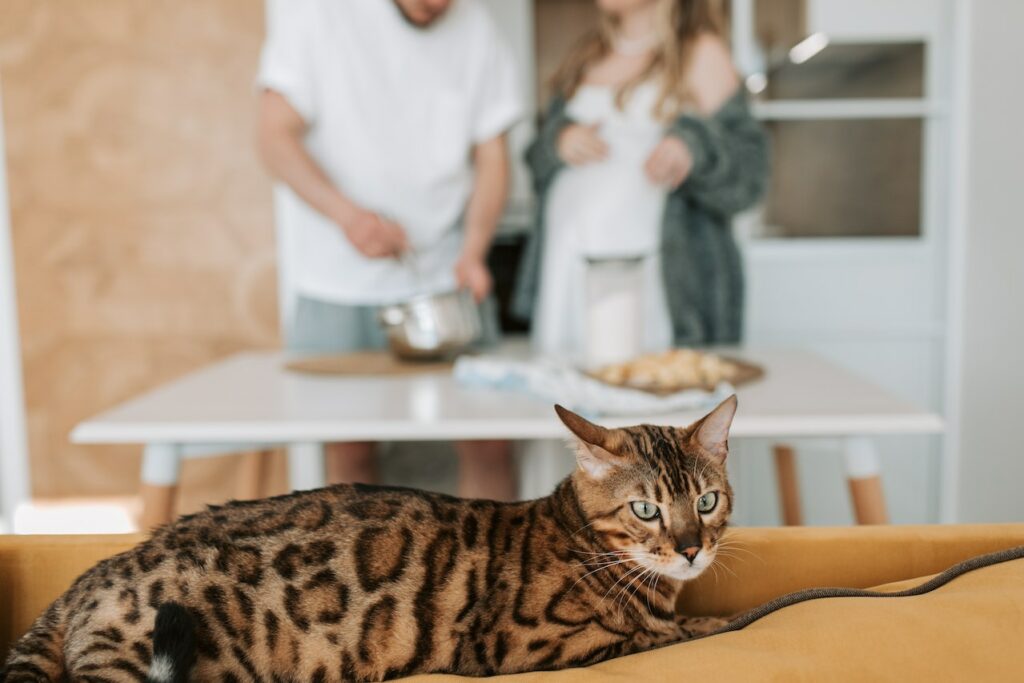What you Need to Know Before Getting a Bengal Cat – All From a Bengal Cats Lifespan to Its Diet
Bengal cats are a popular breed of house pet. They are known for their wild and exotic looks, as well as their playful and curious personalities. However, before you decide to add one of these beautiful creatures to your home, there are a few things you should know. In this article, we will take a look at the origins, temperament, common health problems, and the bengal cats lifespan.
1. What is a Bengal Cat and Where do They Come From
A Bengal cat is a domesticated house pet that is descended from the Asian Leopard Cat. They are bred for their wild-looking features and friendly personality. Bengals come in a variety of colours, including brown, black, silver and snow.
The Bengals have a fascinating history. They were first bred in the early 1980s by crossing Asian Leopard Cats with domestic cats. The goal was to create a house pet that had the wild looks of an Asian Leopard Cat, as well as the friendly personality of a domestic cat.
Since their inception, Bengals have become one of the most popular breeds of house pets. They are known for their beautiful markings and playful personalities. Bengals make great companions and are perfect for families with children.
How Big do Bengal Cats Get and What is Their Lifespan
Bengal cats typically grow to be between 8 and 12 pounds. They are a medium-sized breed and the Bengal cats lifespan is about 10 to 12 years.
What is the Temperament of a Bengal Cat?
Bengals are known for their playful and curious personalities. They are always up for a game of catch and will keep you entertained with their antics. Bengals are also very intelligent and can be easily trained.
As with all cats, Bengals require plenty of exercises. They should be given a minimum of one hour of playtime per day. Bengals also love to explore and can get into a lot of trouble if they are not properly supervised.
Bengals make great companions and are perfect for families with children. They are loyal and affectionate and will bond closely with their human companions.
What are the Common Health Problems of Bengal Cats
Like all breeds of cats, Bengal cats are susceptible to a variety of health problems. Some of the most common health problems include:
-Urinary tract infections
-Diabetes
-Asthma
-Arthritis
Bengal cats are a unique breed of cat, with a distinct wild appearance that sets them apart from other felines. While this breed is admired for its striking looks and outgoing nature, it can also be prone to certain health issues. Here, we’ll take a closer look at some of the most common health problems associated with Bengal cats.
Hypertrophic Cardiomyopathy (HCM)
The Bengal breed has a higher risk than other cats for hypertrophic cardiomyopathy (HCM). HCM is an enlargement of the heart muscle which can lead to congestive heart failure. Symptoms include coughing, difficulty breathing, lethargy and physical weakness. While there is no definitive cause of HCM in Bengals, it is thought to be linked to their genetics.
Weak Immunity
Another potential problem area for Bengal cats is their immune systems. This breed can be more prone to developing infections than other types of cats due to their lower resistance against disease-causing organisms such as viruses or bacteria. Common conditions include feline infectious peritonitis (FIP), feline leukaemia virus (FeLV), and ringworm infection.
Joint Issues
Bengal cats can also have issues with their hips and joints due to their heritage as a hybrid breed between domestic cats and Asian leopard cats. Since they have longer legs than other breeds, they may suffer from conditions such as hip dysplasia or luxating patella which affect the normal functioning of these areas in the body.
Respiratory Problems
Finally, Bengal cats can be susceptible to respiratory problems since they are predisposed to having shorter faces and flatter noses than other felines. This causes them to have narrower nasal passageways which can lead to difficulty breathing or respiratory infections like asthma or bronchitis if not monitored closely enough.
Overall, Bengal cats are beautiful creatures but responsible owners should always be aware of the potential health risks associated with this particular type of feline before deciding whether one is suitable for their family dynamic. Regular checkups from a certified vet are necessary in order to detect any underlying issues early on so that they can be treated promptly and effectively. Additionally, make sure your Bengal’s diet is balanced and nutritious so that they remain fit and healthy throughout their life span!
How Much Does a Bengal Cat Cost and How to Find One for Sale?
The cost of a Bengal kitten depends on its age, gender, quality and where you are purchasing it from. On average, Bengal kittens can range anywhere from $400 to more than $2,000.
There are reputable breeders that have many years of experience in producing healthy and pedigreed Bengal cats who will be able to provide potential owners with their price list.
Additionally, there are also lots of rescue organizations out there that specialize in rehoming Bengals or other cats which provides another great option for those looking to adopt at a lower cost. When searching for a Bengal cat or kitten make sure to do your research and only purchase from responsible breeders!
How to Take Care of a Bengal Cat Once You Have One
Taking care of a Bengal cat is not significantly different from taking care of any other type of domesticated cat, However, before you bring home a Bengal, there are a few things you should know. Bengals require a lot of attention and stimulation. They also require regular vet check-ups to ensure they remain healthy.
Physical Exercise
Bengal cats are extremely energetic and playful cats. They require plenty of daily activity and exercise to stay healthy and fit. Make sure to provide your Bengal with lots of interactive toys and puzzles, as well as plenty of scratching posts for them to climb and sharpen their claws on. This will also help prevent them from destroying furniture or other household items due to boredom or pent-up energy.
Mental Stimulation
Bengals are very intelligent cats, so it’s important to keep them mentally stimulated with regular playtime and stimulating activities. Try teaching them simple tricks such as fetching small objects, or playing hide-and-seek with their favourite toy. Allowing your Bengal access to the outdoors can also be beneficial for their mental health by providing them with plenty of sights and sounds that they wouldn’t experience indoors. However, if you choose to do this make sure they are always supervised due to their natural hunting instincts!
Regular Grooming
Bengals need regular grooming just like any other cat breed. Brush your Bengal at least once per week using a rubber grooming glove or comb to remove excess hair, dirt and debris from its coat. This will help reduce shedding around the house as well as keep their fur looking glossy and healthy at all times. Additionally, make sure you trim your Bengal’s nails regularly so they don’t become too long and uncomfortable for your cat – especially if it tends to scratch the furniture! Also, check its ears regularly for signs of infection or irritation caused by mites or fleas; if you find any then please contact your vet immediately for advice on how best to treat the problem.
Dietary Requirements
Bengals need a good quality diet in order to maintain their energy levels as well as promote strong bones and muscles; this includes proteins such as lean meats, poultry and fish which should make up around 25-30% of their diet along with carbohydrates such as grains which should make up around 10-15%. Additionally, adding some essential fatty acids (like Omega 3) into their diet in order to promote healthy skin & coat; can come in the form of supplements but you can also provide these through certain foods such as flaxseed oil or coconut oil mixed into wet food. Lastly, it’s important that you feed your Bengal twice daily rather than leaving out food all day; this will save you time on cleaning up after it’s eaten all day while also allowing better control over how much food your feline friend consumes each day (which helps prevent weight gain).
Ultimately taking care of a Bengal cat isn’t difficult but does require some extra attention due to its energetic nature; however, if you follow the above steps then you should have no problems providing a happy & healthy environment for your feline companion!
Wrap Up
The Bengal cat is a unique and beautiful breed that comes with its own set of care requirements. If you’re thinking of adding one to your family. Make sure you’re prepared to provide plenty of physical and mental stimulation. As well as regular grooming. Bengals require a good quality diet in order to stay healthy and fit. So be sure to feed them twice daily and give them access to the outdoors under supervision. With proper care, a Bengal cats lifespan is up to 15 years or more!
Getting Insurance
One important thing to keep in mind is that Bengal cats need insurance just like any other pet. Veterinary bills can add up quickly, so it’s important to have coverage in case of an unexpected emergency. At furrr, we believe that no pet should have to go without the medical care they need, which is why we offer affordable policies for both cats and dogs. Visit our website today to learn more about our coverage options. Give us a call to speak with one of our expert agents. We can’t wait to help you protect your furry friend!










